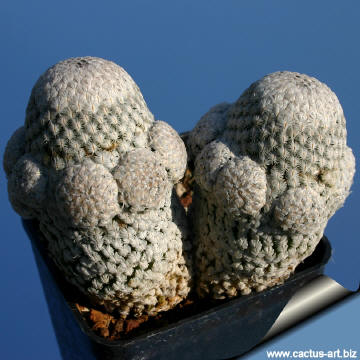|
|
|

A tiny white-spined beauty . It remains small, max 2-4 cm, diameter 3 cm
or less when fully grown (but can grow more and cluster in cultivation)
|
|
 |
 |
|
. |
|
 |
 |
|
. |
|

This plant is
grafted
on
Opuntia compressa. This
grafting stock greatly enhances flower production.
|

Mammillaria sancez-mejoradae and a tree frog
[you can see other macro photographs in the
Gallery of Macro Photografy ] |
|
 |
 |
|
Flowering size speciemens on a frost hardy Opuntia compressa
stock. |
|

Pectinate and feathery spines. |

A pink flowering specimen |
|
Advertising
|
|
|
|
Family:
Cactaceae
Scientific name:
Mammillaria
sanchez-mejoradae
R.Gonzalez G.
First description: Cact. Suc. Mex. 37(3): 55 (1992)
Conservation status: Listed in
CITES appendix 2.

Origin &
habitat:
It is a Critically Endangered cactus endemic to a
single small area (Rancho El Vergel - Municipio de Galeana) in Nuevo
Leon Mexico Altitude 1.900 - 2.000 m. But it is supposed that there
is
more than one population and it could be quite variable.
Synonyms:
-
Escobariopsis sanchez-mejoradae
|
Description:
It is a very slow growing miniature
cactus.
Stem: Usually solitary, flattened globose (or clumps forming over
time) bright green to 3 cm high, 1 - 3 cm in diameter.
Spines: No centrals, 30 to 40 hairlike (or plumose)
pectinate,
rigid radials, white, flattened against the tubercules, to 8 mm long.
Flowers: Can vary between white and pink-rose, 2-3 cm in diameter.
Fruit: Club shaped, red, up to15 mm long.
|
|
|
|


Apex with new spines,
M. sanchez-mejoradae is especially sought after for the incomparable
beauty of its spination.

|
|
Cultivation:
Requires a small pot with fast draining
mineral-based potting mix. The plant should be planted high,
with gravel top dressing partially supporting it above the potting mix.
Pot plants are quite wet-sensitive. Care must be taken
with watering; it needs good drainage. Water sparingly during the
growing season, and keep very dry in winter.
Usually it is recommended to overwinter this plant in a
bright and warm greenhouse with at least 8-10° C , but it
has proved to be
quite frost resistant ( -5° C). Give top shelf treatment. (Full
sun - Light shade)
Propagation: Seeds, cuttings or grafting.
|
|

 |
|